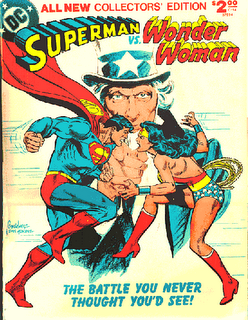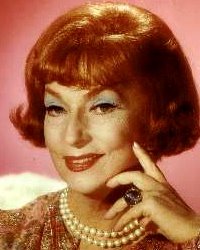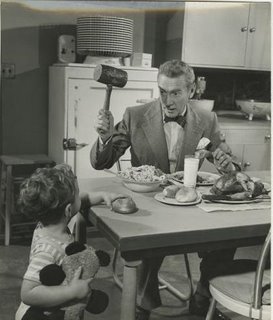 Warner-Brothers executives sweated bullets thinking that audiences will imagine the upcoming Superman movie as “gay.” Under pressure, openly-gay director Bryan Singer publicly disavowed any queer tendencies in his Man of Steel. Superman, Singer stated, “is probably the most heterosexual character in any movie I've ever made.” Um, gee, thanks Bryan. Rather than taking the moment to point out the homophobia that makes such a statement necessary or challenging assumptions about the gay/straight dichotomy, it’s good to see you are striking a blow for heterosexuals everywhere.
Warner-Brothers executives sweated bullets thinking that audiences will imagine the upcoming Superman movie as “gay.” Under pressure, openly-gay director Bryan Singer publicly disavowed any queer tendencies in his Man of Steel. Superman, Singer stated, “is probably the most heterosexual character in any movie I've ever made.” Um, gee, thanks Bryan. Rather than taking the moment to point out the homophobia that makes such a statement necessary or challenging assumptions about the gay/straight dichotomy, it’s good to see you are striking a blow for heterosexuals everywhere.Phobias around Superman’s questionable sexuality suggests that queers simply aren’t welcome as dominate figures in the mainstream media. We might be visible in a film about HIV/AIDS, musical theater, or the quirky hijinks of a straight woman pal – You know, films about “our issues.” Should, though, the topic be centered on national security, war, or even old fashioned super-heroics, queers need not apply. Unless discussing the best way to redecorate your living room, queer folk are best quarantined on some remote reservation for the criminally fabulous. Warner Brothers and Singer stopped just short of promising that Superman Returns promotes compulsory heterosexuality as the most natural and attractive of choices.
Of course, the funny bit in all of this is that the fervor around Superman suggests just how easily his character lends itself to queer interpretations. The overreaction and assertions of his exclusive woman-loving ways only brought into light the many ways that mild-mannered Clark Kent leads quite a queer existence (which Dorian has been having much fun pointing out in his blog).
I have never been a heterosexual man, but I don’t imagine that many of them opt for spandex and long flowing capes (even if we think they should). Superman’s muscles and allegedly titan package illicit the queer gaze. He lives a double life, hiding most of his activities from his perennial suffering girlfriend. The boy also has some serious daddy issues.
What’s missed in all of these discussions are the ways that queer folk have long been playing with the media and tweaking it to match our sensibilities. The reaction against having an openly gay director for Superman ignores the ways that queers have both produced (Singer hardly is the first gay director in Hollywood, kiddies) and/or reinterpreted existing images to meet our own needs.
Popular media icons like Superman invite queer readings. By queer I don’t just mean the modern identities of gay/lesbian (though those are critical to queering the media), but all types of subversive gender and sexual practices that challenge the dominant vision of heteronormativity. Examples? I might have a few:
Superman: 1950s Television Show
Back in the day, a breakfast cereal sponsored the Superman television show. At this time, most advertisers expected the shows’ stars to push their product (talk about the ultimate product placement!). The network, however, deemed it inappropriate to show Clark Kent eating breakfast with Lois Lane lest the audience think that they had spent the previous night in a carnal embrace. The solution? Clark happily served his morning flakes to Jimmy Olsen. Lois, the old spinster, apparently wept bitter tears as she ate cold cereal alone in her apartment.

The network never imagined that the audience might ask, “Just how did Jimmy end up at Clark’s apartment for such an early morning snack?” Now, I am not saying for sure that Jimmy rode Superman like a sweaty bullet train the previous night, but can you say for sure that he didn’t?
The Golden Girls
Few people can dispute the massive gay male following of this 1980s sitcom. Now that it runs ad nauseam on Lifetime Network, an entirely new generation of gay men have adopted it.
The premise of the show, in case you have spent the past twenty years in an isolated jungle tending to the poor, centered on four older women living in one house. Most of their day’s activities involved sitting around eating cheesecake and discussing their sex lives. In took little time for a group of New York drag queens to do the obvious by adopting the scripts and bring their own version of the show to the stage.

What made the show queer? Well, for starters, gay men served as many of the show’s writers. Moreover, the four women rejected conventional assumptions about sex, aging, and friendship. They did not exist as parts of permanent heterosexual couples. Rather, they all dated often. Blanche, especially, defended the positive experience of having sex with somebody for no other reason than being physically attracted to each other.
The Golden Girls’ living situation also suggested some type of Geritol based commune. On more than one occasion, the four women referred to each other as “family,” even irking their biological relatives by doing so.
Ken [Formerly of Barbie and Ken]
Mattel monitors the image of their flagship toy, Barbie, more viciously than the Department of Homeland Security wiretaps U.S. citizens’ phones. You can imagine their trauma when everyone from Dan Savage to People magazine asked “Has Ken Come Out?” in 1993. In that year, Mattel launched a new version of Barbie’s boyfriend. In this incarnation, known as Earring Magic Ken, the doll came with streaked hair, an earring, black hip-hugger jeans, a mesh shirt, and a lavender vest. To complete his look, Ken tossed on (what appeared to most awake observers as) a cockring dangling from his necklace.

Mattel quickly disavowed any queer reading of Ken. Gay men, in contrast, flocked to the stores to snap up the doll.
Mattel’s media relations director declared any queering of Ken was “outrageous” when cultural studies professor Ann DuCille interviewed her the following year. Mattel further explained away Ken’s cock ring as “adults putting their perceptions on something intended for children.” The problem being, of course, that children did not design Earring Magic Ken.
Many have speculated that this Ken emerged as a subversion from within Mattel’s corporate hive-mind. Given the money invested in Barbie, it’s hard to believe that nobody at Mattel mentioned that the new Ken seemed, well, kinda gay. I, for one, would find it hard to believe that gay men aren’t behind-the-scenes in at least part of Barbie’s production. It would be easy to imagine them having a good laugh launching the new doll with sex paraphanalia. Then again, as DuCille points out, perhaps there is something more interesting at play if Mattel attempted to make Ken “hip” and “cool” and ended up with “gay.”
Really, though, Ken had shown his queer inclinations long before he started wearing sex toys as an accessory. Let’s face it, he spent an awfully long time dating Barbie without ever pushing her to get married. Some might attribute this to Ken’s horrific Hemingway crotch (which draws into question the practicality of his cock ring). I think, though, Ken liked the boys. He gladly went shopping with Barbie and wore almost as much pink as she did. Barbie recently dumped Ken, perhaps finally acknowledging the truth to herself.
Remember, Ken, better latent than never.
Bewitched
We can read the entire witch world as decidedly queer in this sitcom. Of course, we all remember our discussion of Uncle Arthur (GayProf will include that post on your midterm exam). Queerness in Bewitched, though, didn’t just imply same-sex desire through Arthur’s flaming personality. Rather, all of the witches expressly rejected the conformity of domestic, monogamous, heterosexual marriage.

The producers of the t.v. show continuously implied that witches’ long term relationships were more open than
The witches flaunted domestic conventions and named Samantha a traitor for giving into Darrin’s demands to live in suburbia. All of the witches and warlocks showed indifference to winning Darrin or anybody’s else approval for the way they lived their lives. On almost every show, one of Samantha’s relatives declared her home a prison or, if in a more polite mood, a drudge.
Of course, the show did not intend to celebrate the witches’ nonconformity. Instead, it used them to illustrate Samantha and Darrin’s wedded bliss. The witches’ world suggested the possibility of queer lives and sexual freedom, but it came as a mixed message. They were, after all, witches.
This type of freedom seemed much like the queer readings of the X-Men movies (coincidentally (wink-wink), Bryan Sanger directed the first two). In that case, queer folk got the uncomfortable label of “mutants.” These types of images gave us freedom and power, but also presented the dangers of sexuality run amok. Queerness in these forms existed only on the fringe of society, among a group of secret outcasts.
Mr. Belevedere
Almost sixty years before the Queer Eye guys appeared on the scene, Mr. Belvedere showed boring, monotonous straight people that they could improve their lives by adding a bit of queerness (Yes, Belvedere’s first film incarnation, Sitting Pretty (1948), inspired the uninspired television show of the 1980s).
In the Belvedere films, the

Within minutes of answering an advertisement for a live-in nanny position, Belvedere showed himself to be fussy, condescending, and theatrical. Why should it come as a surprise that Maureen O’Hara hired him on-the-spot?
Belvedere’s idiosyncratic approach to life quickly made the household run better. Either oblivious or unconcerned, Belvedere never responded to the gossip that quickly spread about a man doing “women’s work” as a nanny. Instead, he showed the family, and ultimately the entire town, just how much better off they are to have a
Mr. Belevdere exists as the protype for the gay Mammy figure. He never fell short of quick wit or a bitchy comment. In a formula that would become a constant in the second-half of the twentieth century, Belevedere’s queer sexuality and gender would be tolerated as long as it served the needs of the heterosexual family. Moreover, the most we knew of his own sexual interests came only in being told that he “never married [a woman].”
All of these types of queer images, of course, kept queer sexuality under wraps. Mr. Belevedere put his libido on the back burner while he helped the really important people in society, the child-producing heterosexuals.
At the same time, though, these types of queer images also allowed young queer folk opportunities to fantaize. They allowed us to dream about creating a life that did not focus on newly-built suburban houses and whiny children clinging to our pants. After all, Mr. Belvedere left suburbia and his needy heteros behind once he became a famous author (writing a book, incidently, that mocked the hetero hyprocrisy that surrounded him).

These types of queer images offered an opportunity to see individuals who rejected monogamous heterosexual marriage and got to have fun. Neither Belvedere nor Blanche took the judgements of those around them seriously.
None of these characters or scenarios offered direct validation of same-sex desire. Queer images like these, though, offered an escape from the doldrums of traditional hetero marriage and the masochism of trying to be something we were not. We are constantly drawn to these types of images because they hint, if only coyly, at sexual liberation.




21 comments:
As usual, this was very thought provoking. I will never see Bewitched the same way again, lol.
Sitting Pretty indeed! Once again, you inspire us all Gay Prof.
"People confuse Batwoman with the character Batgirl."
And it's driving me batshit!
"More Americans can recount Kevin Federline's life history than could name any single accomplishment of César Chávez."
So is this.
"Many Americans will likely consider Nacho Libre a documentary."
This just scares the shit out of me. Mind, it does not surprise me, it just scares the shit out of me.
I love your blog and I'm sorry it's taken me so long to find it. I'll work on "Ten Reasons Why I Adore and Worship GayProf" as soon as I finish reading all of it.
i think it's very important that you stress they only hint at sexual liberation, as i feel all of these examples, in turn, do their part to reinforce heteronormative gender roles and sexuality.
while they all present examples of deviant or subversive sexualities, genders, and social structures, they all, as well, inform that truer happiness comes from conformity to status quo.
yes, each lends itself to queer readings, and i am sure that's your point, but despite that lending, each also works to deflect queer interpretations.
...oh how i miss studying this stuff. alas, perhaps one day, once again.
"Jimmy rode Superman like a sweaty bullet train the previous night"
Oh man... there is no way I am going to see Superman the same way evewr again :)
Having seen both X-Men movies directed by Singer, I would think he might want to worry less about Superman being perceived as gay and more about his movie being a poorly scripted mish-mash with too many characters vying for screen time.
But that's just me.
I would suggest that similar themes run through all the Bugs Bunny cartoon - Bugs was the utter nonconformist (even in gender issues), and yet he was always having a ball.
Brilliant piece, thank you!
Paul
What, no Dr. Smith from Lost in Space?
"Oh the pain... the pain of it all!"
I have an Earring Magic Ken, and you are jealous. ;)
And speaking of Paul's comment above, I have an essay somewhere entitled "Bugs Bunny: Queer as a Three-Dollar Bill" that I can't find for the life of me. Google is also baffled. If I ever find the thing, I promise to re-publish it on my blog.
I guess I am surprised by your omission of the TV batman series - or does even the straight world admit that one was queer now? Thanks for clearing up the previously puzzling gay attraction to Golden Girls.
And what about the lesbian classic cop show Cagney & Lacey?
Another example could be the TV series, Family Affair. Mr. French, of course was the hirsute gentleman's gentleman, attending to the needs of his hyper-masculine, Uncle Bill, who just happened to be another victim of confirmed bachelorhood. And, of course, the family jewels were featured in the title sequence.
Fantastic post. Really thoughtful. And now I am convinced, more than ever, that I *am* in fact a gay man, since I love(d) all of the things on this list, without ever being able to understand why.
You've shown me the light, GayProf!
I do have to somewhat agree with Brett that these characters in some ways only strengthen the heteronormative presumptions by showing what it isn't. Maybe Golden Girls was the best at not doing this. Thought provoking indeed.
This is some wonderful queering, Gay Prof! You are so much better at queering our culture than the misanthropic Lee Edelman and the kooky Judith Halberstam!
Maybe Golden Girls was the best at not doing this.
I might be biased as someone who has actually gone out and purchased all five seasons of "Golden Girls" that are now out on DVD, but I'd vouch for this. Especially after the second season, it became clear that the main characters referred to themselves as a "family" and the conflict in many episodes emerged when their external relationships infringed on their self-constructed family dynamic.
Oh, and GayProf, what about "Designing Women", Lifetime's other always-run?
Yeek. "Magic Earring Ken"...?
There's no mistaking that character as being a little on the queer side, jewelry and all.
1993 was the year that those bleached tips started to take off, no?
And the PERFECT WW cover for the posy.
well...i have to say you write the most thought provoking things. i have done a long entry in my own blog with my own, somewhat superficial, reflections of the things you've talked about. then i emailed the head of the women and genders studies department at my university and recommended your blog to her as something she might want to consider reading.
did you know that at one time (and maybe still) lynda carter was a born again christian type? sorry, someone had to tell you if you didn't already know.
i hope your move is uneventful and painless.
Great post, sir. This is my first visit to your site, but I am definitely impressed.
Heteronorming be damned, I grew up on friggin' Golden Girls. Astute observations though, and very funny. But wow, that new Ken doll. Damn. Looks like a Backstreet Boy. I think you're right on that one too.
Anyway, pleasure to read you. I'll be back.
Awesome post! As a scholar of media and popular culture, particularly queer readings of popular culture, I thoroughly enjoyed your take on these icons.
I just watched "The Celluloid Closet" about this issue in film. Pretty interesting stuff. So then I rushed up to my computer and ordered the book from the library.... But really, queer content is everywhere if you know how to look for it and nowhere if you don't. I managed to read The Picture of Dorian Gray in my very early 20s and never picked up on the fact that there was anything the least bit queer about the book.
Post a Comment